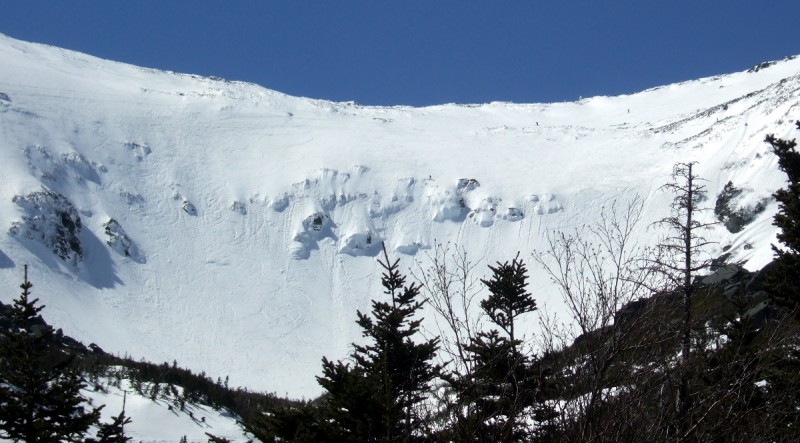
Tuckerman Ravine is loaded with lore, bragging rights and hazards.
The annual spring migration is well under way.
Odd birds? Perhaps, but these two-legged creatures have no wings yet they often take flight—sometimes unwittingly—while schussing down the steep slopes and gullies of the Eastern United States’ most popular spring skiing and snowboarding destination without a chairlift.
The promise of sunny days, kernels of corn snow, and bragging rights tempt the masses to venture to Tuckerman Ravine, the spring (and sometimes summer) mecca on the eastern shoulder of 6,288-foot Mount Washington in New Hampshire.
Prevailing winds carry copious amounts of snow into the jagged ravine with the possibility of holding snow and ice year-round.
The intrepid carry only what they need and hike the three miles to the base of the gargantuan bowl with its own culture and nomenclature with runs like Hillman’s Highway, Left Gully, and Right Gully. They venture over the Headwall, and the Lip while in the Bowl. Like the Roman gallery of yore, the public sits at Lunch Rocks, a collection of open boulders, and give their approval or not about the line skiers and riders take.
If they fall, there is often a “yard sale” with gear scattered about.
Tucks (some call it Tuckerman’s but that’s just not right) is loaded with history, but most significant this spring is the 75th anniversary of Toni Matt’s legendary April 16, 1939 blistering run during the last American Interno Race from the summit. He skied down from the summit of Mount Washington all the way to the bottom in just under six and a half minutes.
The record stands.
The December 1939 issue of the magazine Appalachia said Matt’s run “cannot fail to take your breath away.”
Matt died at the age of 69 in 1989.
With all its glory, there are inherent dangers to making the pilgrimage. Not every visitor pays attention. There are skiers and riders with incredible skill sets, and those who are clueless. People die. Avalanches happen. There are deep sinister crevasses.
Snow rangers from the US Forest Service Mount Washington Avalanche Center remind visitors to check the daily avalanche advisory at mountwashington.org and to be flexible in their plans.
Though this season has seen cold weather and plenty of snow, typical spring hazards are emerging rapidly.
These hazards include falling ice, undermined snow, crevasses, and possibly avalanches if a late season snowfall event occurs.
According to Jeff Lane, falling ice is one of the most dangerous hazards in Tucks each spring.
“We want people to understand that the blocks of ice that fall can be as large as a school bus, and can explode into thousands of pieces flying in every direction when they hit rocks,” he said.
Over the years Lane and his colleagues have seen falling ice severely injure and kill a number of people.
“The worst-case scenario is having people sitting at Lunch Rocks when the ice above crashes through it. People can watch all the action from a much safer location farther down in the Bowl,” he says.
Although Lunch Rocks has been a traditional place to sit for a snack or lunch, this area has been the number one accident location in the Ravine over the decades.
Lead snow ranger Christopher Joosen believes a better name for the rock jumble would be “Icefall Rocks.”
In addition to falling ice, undermined snow and crevasses present challenges and risk for backcountry skiers as well. Crevasses are formed when the winter snowpack slowly creeps downhill, pulling away from the slope above. Undermining occurs when water melts the underside of the snow, creating a hollow space that people might fall into. When these spaces are above a stream or close to rock ledges, the consequences can be severe.
The snow rangers strongly advise visitors to stay away from the edges of crevasses and undermined areas. The holes beneath the snow can be much larger than the visible opening.
As any good scout knows, planning ahead is worth it.
Image by Steve Bennett on the Wikimedia Commons
 Your Privacy Choices
Your Privacy Choices
 The
The